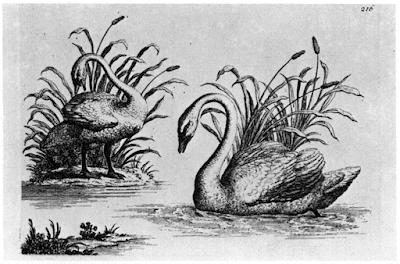 |
| Enamel swan bonbonnière, c. 1760-1770. Privately sold (English Enamel Company). |
Box 1
This swan bonbonnière (sweet box) adds another form to the range of animals produced in enamelled copper boxes in the later eighteenth century, made in the Birmingham, Bilston or Wednesbury areas. The swan is simply painted with festoons of grey dots forming the plumage on the body and more intricately painted wing feathers in three kinds. Other animals were made sitting on grassy mounds, such as frogs and tigers. The base of this swan box is below.
 |
| Base of swan bonbonnière, above. |
 |
| Enamel swan bonbonnière, c. 1760-1770. Privately sold (English Enamel Company). |
Another swan bonbonnière depicts an elongated swan, seemingly nesting on the river. The base of the box contains an image of two swans swimming, a common image on several enamel boxes made in Birmingham or the Black Country during this time. The first known transfer-printed enamel had a pair of swans in the foreground. To collectors, this is sometimes termed the 'swan group'.*
 |
| Base of swan bonbonnière, above. |
Gallery: Other Swan Enamels
 |
| Enamelled and transfer printed box, c. 1750-1770. Wolverhampton Museum and Art Gallery (EM56). |
Birmingham and Bilston enamellers were constantly looking for inspiration for new designs and would often use a variety of popular prints. The box above shows direct influence from a Wenceslaus Hollar print produced between about 1654 and 1658, below. Despite the age of the print, it seems that a box designer had purchased this print, or a later copy, to influence their design.
 |
| Wenceslaus Hollar Collection. |
Other enamel swan designs are similar to the prints included in the new range of illustrated design books. These were often marketed to the home crafter, such as The Ladies Amusement (1760), but dozens of enamels include imagery either directly taken from these books, or bearing strong similarities to it.
 |
| Plate from a set of six prints of birds and squirrels, complied by Robert Sayer, c. 1758. |
A Ladies Amusement was published in 1760 by Robert Sayer and included 122 leaves of plates produced by several engravers, many of which he had previously issued separately, usually in sets of six. The swans above were the fourth print in a such a set of six which were engraved by J. Jones, themselves taken from engravings by Francis Barlow produced in the mid-1660s.** These six prints cost 6d, an easy price for a Birmingham or Bilston artisan wishing to expand their repertoire of imagery to adorn their enamelled boxes with.
Historian Helena Hayward states that seventeenth-century prints of birds and other animals, such as by Barlow and Hollar, were admired in the eighteenth century for their 'lively and naturalistic manner and provided a vivid impression of the appearance, movements and behaviour of animals and birds'.** Applying these images to boxes and other enamel wares, easily transportable in eighteenth-century pockets, allowed these lively swans to be admired beyond the bounds of paper prints, but in any social setting.
 |
| An enamelled pendant, transfer printed and overpainted, probably made in Birmingham, c. 1755-58. Sold at Bonhams in 2008 for £1,140. |
The pendant above contains the same image as included in a 1757 print, below. In this example the pendant may not have copied the print but vice-versa, as the print was taken from a drawing by C. Fenn, probably Charles Fenn who is considered to have been an enamel painter in Birmingham.*3* So, Fenn may have designed the transfer print for the pendant before providing it for publication.
 |
| For Japanning, C. Fenn Delin and P. Benazech Sculp, 1757, printed for John Ryall and Robert Withy, and Robert Sayer. Yale Center for British Art. |
Notes
© Jen Dixon 2021. All text belongs to the author, contact jenni.a.dixon@gmail.com.
* Susan Benjamin, English Enamel Boxes: From the Eighteenth to the Twentieth Centuries (London: Orbis Publishing, 1978).
** Helena Hayward, 'Engraved Ornamental Designs After Francis Barlow', Furniture History (1975), 43-45. Vol 11, p. 43.
** Helena Hayward, 'Engraved Ornamental Designs After Francis Barlow', Furniture History (1975), 43-45. Vol 11, p. 43.
